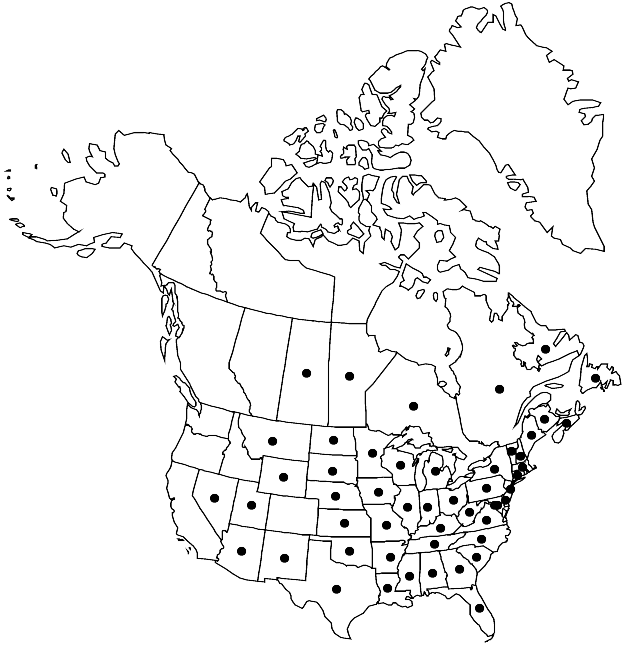Difference between revisions of "Brachythecium laetum"
in P. Bruch and W. P. Schimper, Bryol. Europ. 6: 24. 1853.
FNA>Volume Importer |
FNA>Volume Importer |
(No difference)
| |
Revision as of 19:46, 24 September 2019
Plants medium-sized, in moderately loose to dense mats, light green, sordid green, or yellowish to brownish. Stems to 7(–12) cm, creeping, terete-foliate, irregularly pinnate, branches to 12(–25) mm, straight to slightly curved, terete-foliate. Stem leaves erect, loosely to densely imbricate, narrowly ovate-triangular, broadest at 1/12–1/8 leaf length, partially concave, deeply plicate, (1–)1.3–2.2 × (0.4–)0.6–1 mm; base rounded, decurrent; margins plane or recurved at places, serrulate almost to base; apex gradually acuminate; costa to 55–75% leaf length, moderately weak, terminal spine absent; alar cells subquadrate, same size as or smaller than basal cells, (8–)10–13 × 10–15 µm, walls thin, region not clearly differentiated, to 8–15 cells along margins; laminal cells elongate, 25–70 × 5–8 µm; basal cells small, 15–25 × (6–)8–11 µm, region in 3 rows near costa, opaque, markedly different from more distal cells. Branch leaves less plicate; costal terminal spine sometimes present. Sexual condition dioicous. Seta brownish orange, 0.7–2.5 cm, smooth. Capsule slightly inclined, brownish orange, cylindric, slightly curved distally, 2–2.6 mm; annulus not separating; operculum long-conic or short-rostrate. Spores 14–16 µm.
Habitat: Soil, rock, open and moderately shaded habitats, lowlands
Elevation: low to high elevations (0-2300 m)
Distribution

Man., N.B., Nfld. and Labr., N.S., Ont., Que., Sask., Ala., Ariz., Ark., Conn., Del., D.C., Fla., Ga., Ill., Ind., Iowa, Kans., Ky., La., Maine, Md., Mass., Mich., Minn., Miss., Mo., Mont., Nebr., Nev., N.H., N.J., N.Mex., N.Y., N.C., N.Dak., Ohio, Okla., Pa., S.C., S.Dak., Tenn., Tex., Utah, Vt., Va., W.Va., Wis., Wyo., Mexico (Coahuila, Jalisco, Nuevo León, Tamaulipas), s Europe, sw Asia.
Discussion
Brachythecium laetum is a widespread, variable, often weedy species of eastern North America. Plants from temporarily flooded ground or growing on dusty and heavily trampled soil are difficult to identify; these have small, short leaves with weak plication especially in branch leaves, the opaque region across leaf base is not conspicuous, and the isodiametric cells are confined mostly to leaf corners. Those plants have been identified as B. salebrosum, but B. salebrosum has autoicous sexual condition and long cells reaching almost the base in proximity to costa. Plants of B. laetum have long-hexagonal cells in the leaf base, often in conspicuous transversal rows, and relatively short cells in the acumen. Occasionally it is difficult to differentiate small plants of B. laetum from xeric habitats and B. acuminatum; important characters of the latter species include small plants, leaves never falcate, thick-walled distal laminal cells, and larger basal cells forming a usually neither pellucid nor opaque or, sometimes, slightly pellucid belt across leaf base. Brachythecium digastrum was synonymized with B. laetum by M. S. Ignatov et al. (2008). The name Brachythecium oxycladum of American authors but not (Bridel) A. Jaeger has been applied to many specimens that are B. laetum.
Selected References
None.